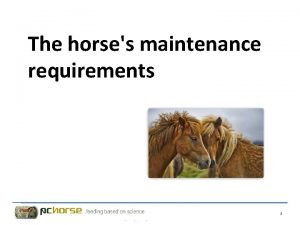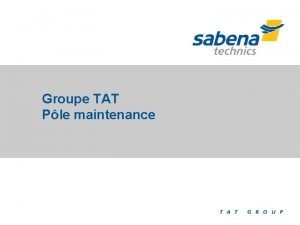MAINTENANCE ORUN BLEN 2009503016 WHAT IS MAINTENANCE Maintenance

MAINTENANCE ORÇUN BİLEN 2009503016

WHAT IS MAINTENANCE ? Maintenance involves fixing any sort of mechanical or electrical device which has become out of order or broken. • It also includes performing routine actions which keep device in working order or prevent trouble from arising. •

WHAT DOES MAINTANANCE DEPARTMENT DO IN COMPANY ? Maintenance department implements some maintenance operations to produce products according to specific criteria. �

WHAT IS THIS CRITERIA? Before this department implement s maintenance operations, they can be categorized by whether the product remains the property of the customer, service is being offered, or whether the product is bought by the reprocessing organization and sold to any customer wishing to make the purchase. �

MAINTENANCE TYPES: 1. Preventive Maintenance: 2. Corrective Maintenance:

PREVENTIVE MAINTENANCE: Preventive maintenance can be described as maintenance of equipment or systems before fault occurs. �

CORRECTIVE MAINTEANANCE: Corrective maintenance is probably the most commonly used approach, but it is easy to see its limitations. When equipment fails, it often leads to downtime in production. In most cases it is costly business. Also, if the equipment needs to be replaced, the cost of replacing it alone can be substantial. It is also important to consider health, safety and environment issues related to malfunctioning equipment. �

DIFFERENCE BETWEEN PREVENTIVE AND CORRECTIVE MAINTANANCE: While preventive maintenance is generally considered to be worthwhile, there are risks such as equipment failure or human error involved when performing preventive maintenance, just as in any maintenance operation. � Preventive maintenance as scheduled overhaul or scheduled replacement provides two of the three proactive failure management policies available to the maintenance engineer. �

To Make It Simple: Preventive maintenance is conducted to keep equipment working or extend the life of the equipment. � Corrective maintenance, sometimes called “repair” is conducted to get equipment working again. �

BRANCH OF MAINTENANCE: Ø Ø Condition-Based Maintenance Predictive Maintenance Reliability-Centered Maintenance Value Driven Maintenance

CONDITION-BASED MAINTENANCE: Shortly described, this maintenance is performed after one or more indicators show that equipment is going to fail or that equipment performance is deteriorating. � CBM was introduced to try to maintain the correct equipment at the right time. CBM is based on using real-time data to prioritize and optimize maintenance resources. �

PREDICTIVE MAINTENANCE: Techniques help to determine the condition of in-service equipment in order to predict when maintenance should be performed. This approach offers cost savings over routine or time –based predictive maintenance, because tasks are performed only when warranted. �

RELIABILITY-CENTERED MAINTENANCE: It is generally used to achieve improvements in fields such as the establishment of safe minimum levels of maintenance, changes to operating procedures strategies and the establishment of capital maintenance regimes and plans. � Successful implementation of RCM will lead to increase in cost effectiveness, machine uptime. And a greater understanding of the level of risk that the organization is presently managing. �

VALUE DRIVEN MAINTENANCE: A cash flow is the difference between income and expenditure. It is not the difference between turnover and costs, because this is easy to manipulate through accounting. There are companies that use highly creative lease, depreciation and reservation techniques to keep book profits artificially high or low, this doesn’t always contribute to shareholder value. Recent stock market scandals are a painful but revealing illustration of what sometimes happens as a result of this. �

The second part of the definition concerns the knowledge the value of a cash flow is timerelated, given the term “present value”. Future cash flows must be corrected or discounted to today. Managing by value necessitates maximizing future cash flows. Managing by value obliges companies constantly to search for new free cash flows. It is no longer enough for a company to go on doing what it is already doing. Today, it's all about creating value

Thank you for listening to me ORÇUN BİLEN 2009503016
- Slides: 16






























